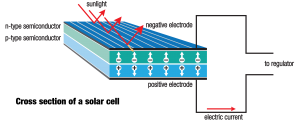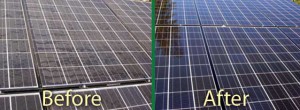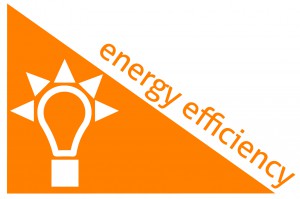
How does a solar panel work? A solar panel transforms sunlight into electrical power by means of the so-called photovoltaic effect, without emitting any greenhouse gases. This technology truly has numerous advantages from an environmental point of view, although research will be introducing many more: particularly in terms of efficiency and cost.
Today’s best-performing modules can achieve a conversion efficiency of a little over 25%. Conversion efficiency measures the ratio between the solar irradiation received from the panel and the amount of electrical energy it effectively produces.
A single, average-sized photovoltaic panel, measuring 1 metre by 1 and a half metres (and 2-3 cm thick) is capable of producing at least 200 watt of electrical power and is able to produce a peak power in excess of 300 watt. Ten 300 watt PV panels electrically connected to each other constitute a classic, “standard” plant in Italy with a 3 kilowatt peak power, capable of producing an average of 3,300 kWh per year (in northern Italy) and up to 4,500 kWh per year (in southern Italy).
A photovoltaic panel works using photovoltaic cells. These are the basic elements which trigger the photovoltaic effect, the physical reaction able to produce energy from the sun.
Let us give you a brief introduction.
The sun has been irradiating energy on to the Earth for billions of years, providing an abundance of light and heat. To give you an idea: in less than an hour the sun sends our planet as much energy as the entire world population uses in a year. This gives you an idea of the sun’s enormous potential. It is estimated that every square metre of the sun’s surface irradiates the same amount of energy as 6,300 litres of diesel oil in one hour.
Without going in to too many technical details, we can briefly explain how a photovoltaic panel works. How does it produce electrical energy from sunlight? What is the physical mechanism?
Sunlight is converted into electricity inside the solar cells, which are electrically connected to each other to form the photovoltaic panel.
The cells are made of one of the most common materials found in nature: silicon. Technically speaking: solar grade silicon.
What is “solar grade silicon”?
This is the most popular material used today to produce photovoltaic cells and it is a component which does not exist in a pure state in nature, because it reacts with oxygen: in fact it is found naturally in the form of Silicon Oxide or other composites, such as sand, quartz and clay. The silicon is extracted from the mines and purified via specific chemical processes. The maximum level of purity, equal to 99.9%, is solar silicon. This is suitable for the photovoltaic industry.
This element has special electrical characteristics: it is a semiconductor material, which means its electrical conductivity lies halfway between that of conductors (e.g. metals) and that of non-conductors (e.g. wood or plastic). The electrical conductivity of this material can actually be varied “artificially” as a result of a process of “doping” the material (the addition of positive or negative charges).
A photovoltaic cell consists of two layers: a negatively doped layer and a positively doped layer. When sunlight hits the panel, the photons generate a physical reaction via different charges to create an electrical field of direct current.
So the photovoltaic panel provides direct current which, in order to be used by most appliances, has to be converted into alternating current by the inverter.
This is a summary of the physical mechanism behind how the photovoltaic cell works. Thanks to this physical reaction, each panel is able to generate direct electrical current, starting from the charge imbalance between the two layers of pure silicon.
We obviously need to clean the photovoltaic panels to increase their efficiency and energy production.
 More often than not it’s the rain that cleans your photovoltaic panels. Rain can clean photovoltaic panels, but it doesn’t always clear away all the dust and dirt which restrict the active surface. This is when you have to step in to wash and maintain your system.
More often than not it’s the rain that cleans your photovoltaic panels. Rain can clean photovoltaic panels, but it doesn’t always clear away all the dust and dirt which restrict the active surface. This is when you have to step in to wash and maintain your system.

